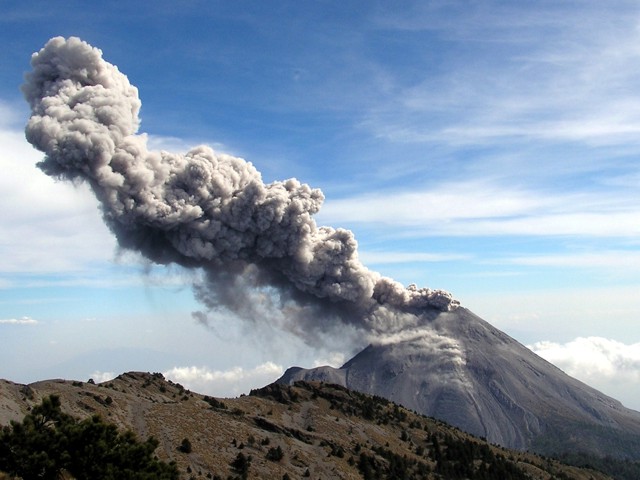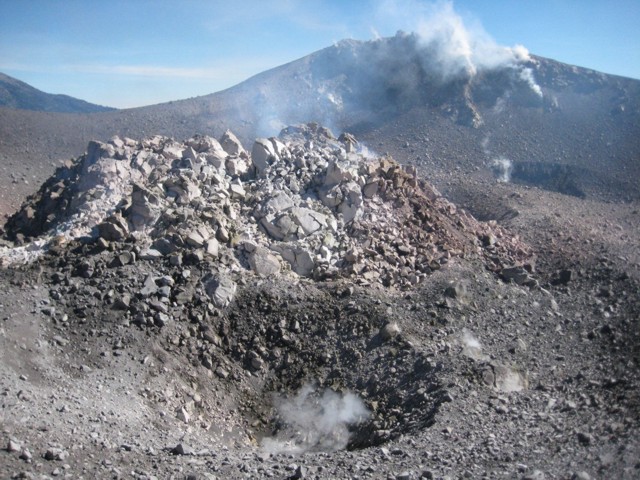Report on Colima (Mexico) — October 2007
Bulletin of the Global Volcanism Network, vol. 32, no. 10 (October 2007)
Managing Editor: Richard Wunderman.
Colima (Mexico) Small eruptions continue with dome growth and plumes
Please cite this report as:
Global Volcanism Program, 2007. Report on Colima (Mexico) (Wunderman, R., ed.). Bulletin of the Global Volcanism Network, 32:10. Smithsonian Institution. https://doi.org/10.5479/si.GVP.BGVN200710-341040
Colima
Mexico
19.514°N, 103.62°W; summit elev. 3850 m
All times are local (unless otherwise noted)
Eruptive activity between July 2005 and February 2006 included ash plumes up to 10 km in altitude, lahars to a length of about 10 km, pyroclastic flows, and landslides (BGVN 31:03). Periodic eruptions have continued through at least 1 November 2007, with resulting ash or ash-and-steam plumes, some of which reached an altitude of 6.1 km (6.7 km on 30 November 2006). Some plumes have been detected by satellite imagery.
During 21-27 March and 22-30 April 2007, incandescent material from Colima reached as high as 50-150 m above the summit. Information for this report was provided by the Washington Volcanic Ash Advisory Center (VAAC), based on the Mexico City Meteorological Watch Office (MWO), the Volcanological Observatory of Colima University, and satellite imagery.
In July and November 2006 and August 2007, State government officials warned that the threat of eruptions at Colima continued and that overflights without scientific or civil defense objectives were restricted. The officials also warned population to stay out of ravines near the volcano during the rainy season for fear of lahars.
According to the State government of Colima, on 16-17 November 2006, ashfall was reported in villages near the volcano, including Cuauhtémoc and Colima.
According to Vyacheslav Zobin, the period from October 2005 to January 2007 was characterized by small steam-and-ash Vulcanian explosions (figure 81). Beginning in January 2007, the small explosions increased in number, but decreased in both their energy and the total ash fraction. Zobin explained that this change marked the beginning of a new episode of lava dome growth in the crater (figure 82), first observed on 9 February 2007. Dome growth continued (figure 83) with a low mean effusion rate of about 0.01-0.03 m3/s during February-October 2007 and reached a volume of about 60,000-80,000 m3.
 |
Figure 81. Photograph showing a typical Vulcanian explosion at Colima, 10 March 2007. Courtesy of Colima Volcano Observatory. |
 |
Figure 83. Photograph of a new lava dome in the crater at Colima, October 2007. Courtesy of Jeff Johnson, New Mexico Institute of Mining & Technology. |
Geological Summary. The Colima complex is the most prominent volcanic center of the western Mexican Volcanic Belt. It consists of two southward-younging volcanoes, Nevado de Colima (the high point of the complex) on the north and the historically active Volcán de Colima at the south. A group of late-Pleistocene cinder cones is located on the floor of the Colima graben west and east of the complex. Volcán de Colima (also known as Volcán Fuego) is a youthful stratovolcano constructed within a 5-km-wide scarp, breached to the south, that has been the source of large debris avalanches. Major slope failures have occurred repeatedly from both the Nevado and Colima cones, producing thick debris-avalanche deposits on three sides of the complex. Frequent recorded eruptions date back to the 16th century. Occasional major explosive eruptions have destroyed the summit (most recently in 1913) and left a deep, steep-sided crater that was slowly refilled and then overtopped by lava dome growth.
Information Contacts: Vyacheslav Zobin, Observatorio Vulcanologico, Universidad de Colima, Av. Gonzalo Sandoval 444, Colima, Col. 28045, Mexico; Observatorio Vulcanológico de la Universidad de Colima, Colima, Col., 28045, México (URL: https://portal.ucol.mx/cueiv/); Washington Volcanic Ash Advisory Center (VAAC), Satellite Analysis Branch (SAB), NOAA/NESDIS E/SP23, NOAA Science Center Room 401, 5200 Auth Rd, Camp Springs, MD 20746, USA (URL: http://www.ospo.noaa.gov/Products/atmosphere/vaac/).


